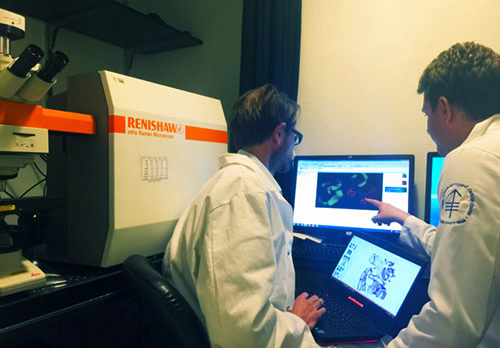Members Login

Channels
Special Offers & Promotions
The World-Renowned Memorial Sloan Kettering Cancer Center in New York City uses a Renishaw inVia Confocal Raman Microscope, in the Kircher Laboratory, to Support the Development of Nanomolecular Probes
The Kircher laboratory at Memorial Sloan Kettering is developing novel nanoprobes for molecular imaging, image-guided therapy and theranostics.
 Its ultimate goal is to develop a universal technology that allows precise determination of the actual spread of a tumour in vivo. Currently surgeons cannot see the microscopic extent of the tumour during a procedure, which is essential information for tumor removal and avoiding excess tissue excision.
Its ultimate goal is to develop a universal technology that allows precise determination of the actual spread of a tumour in vivo. Currently surgeons cannot see the microscopic extent of the tumour during a procedure, which is essential information for tumor removal and avoiding excess tissue excision.
Physician-scientist Dr. Moritz Kircher is working on a new generation of nanometer-sized imaging beacons. These allow detection, during surgeries and minimally invasive procedures, of the macroscopic extent of the primary tumour, its true microscopic spread, as well information on satellite micrometastases. These nanobeacons can be located using surface enhanced resonance Raman scattering (SERRS), which can be combined with other whole-body imaging methods, such as magnetic resonance imaging (MRI) or positron emission tomography (PET).
SERRS is a highly sensitive technique utilising a resonance Raman effect, combined with a surface enhancement obtained from nanoparticles to give dramatic enhancements to the normally weak Raman signal. The advantages of the SERRS method is also utilised by Renishaw Diagnostics in their recently launched CE certified RenDX Fungiplex assay IVD device.
Dr. Kircher is a member of the Department of Radiology, the Center for Molecular Imaging and Nanotechnology and the Brain Tumor Center. He chose the Renishaw inVia confocal Raman microscope for the Kircher Laboratory, following his positive experience of using the instrument–and the successful research he obtained–during his post-doctoral studies at Stanford University, in the group of Professor Sam Gambhir. He has gone on to publish several high profile papers using inVia's results.1 Dr. Kircher said, “Our aims are to visualise any cancer type with the ultrasensitive Raman nanostar particles my group has developed. This includes providing high precision intraoperative guidance to surgeons, so that they can, with confidence, visualise and excise all cancer cells completely and without having to sacrifice too much normal tissue around the tumour. In addition, our SERRS nanoparticles are not only universal with regards to tumour type, they also allow us to detect microscopic tumour extensions from the main tumour into the periphery, microscopic loco regional metastases and even premalignant lesions.”
Most recently, the group has published an overview paper in the Journal of Nuclear Medicine2 which cites SERRS as a new modality for cancer imaging. The authors concluded that the increased accuracy in visualising the full extent of tumour spread provided by the SERRS signal could increase the precision with which cancers can be resected or destroyed, be it via open surgery or minimally invasive techniques used by interventional radiologists. With the application of SERRS in diagnostics and cancer detection the future for the application of Raman spectroscopy in this field looks very promising.
Media Partners


